Kendall-Jackson Wine Center
During the afternoon of our anniversary, Jen and I chose to have a relaxing picnic in the gardens of the Château at Kendall-Jackson Wine Center. We dined on fresh olive bread, exotic goat cheeses, dried fruits, and hot tamales surrounded by flowers, grape vines, vegetables, and fruit trees in a spread of land they aptly named the Culinary and Sensory Gardens. The beautiful floral display was designed by British horticulturalist Adrian Bloom of Blooms of Bressingham while the rest of garden is divided up into the wine sensory garden, which "identify aromas and flavors used to describe wines, and to suggest herbs and produce that pair well with each varietal," and the culinary garden, which highlight the cuisines of France, Italy, Asia and South America, medicinal herb gardens, seasonal fruits, and vegetables.
The gardens were an amazing classroom of culinary learning especially with Jen teaching me along the way. Here's a sampling of what I saw, smelled, and tasted:
I learned about lemon verbena. An herb used to mimic the tastes and smells of lemon. It really does too!
Next, I came across the epazote plant. Used primarily in Latin American cooking, it is difficult to describe, but upon smelling it, there arose a distinct familiarity.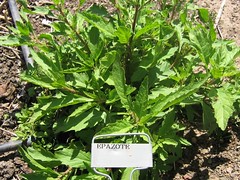
The most mysterious plant I saw was the black current. As Jen's Wine Clubbers will know, when you don't know how to describe a red wine just say it tastes like black current because no one (at least, on one around here) knows what black current is. It is much more prevalent in England where they sell black current jam. I took this picture for the whinos out there. To bad, there wasn't any fruit to taste.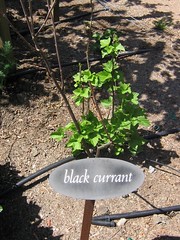
The weirdest vegetable was by far the cardoon plant. My new Food Lover's Companion lists the cardoon as
Tasting like a cross between artichoke, celery and salsify, this delicious vegetable is very popular in France, Italy, and Spain. The cardoon resembles a giant bunch of wide, flat celery and can be found from midwinter to early spring. Though high in sodium, cardoons are a good source of potassium, calcium and iron.
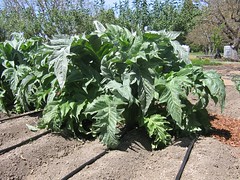
My most memorable image in the gardens was seeing asparagus growing from the ground for the first time. Not unfamiliar by any means, the asparagus plants still invoked a weird imagery of testicles coming up from the ground.
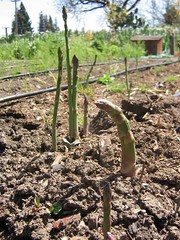
Culinary Word of the Day: Epazote
A pungent, wild herb whose strong flavor is, like that of fresh coriander, an acquired taste. It has flat, pointed leaves and is available dried (and infrequently fresh) in Latin markets. Also called Mexican tea and wormseed, epazote is popular in many bean dishes because it's a carminative, which means it reduces gas. Source: Food Lover's Companion
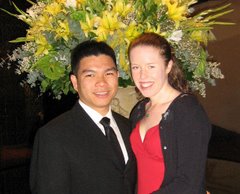






1 comment:
I discovered last week that it really is a safe bet to say that any red wine has an aroma of black currants!
Trader Joe's carries 100% black currant juice, so I bought a bottle out of curiosity. It smells (drumroll, please) like red wine. That is, I recognized the juice's smell as the ubiquitous background smell of red wine, on top of which I pick out other notes like berries or herbs or spices or whatever.
The unsweetened black currant juice tastes really tart, though. I think I'll bring a bottle to the next gathering of Wine Club.
Post a Comment